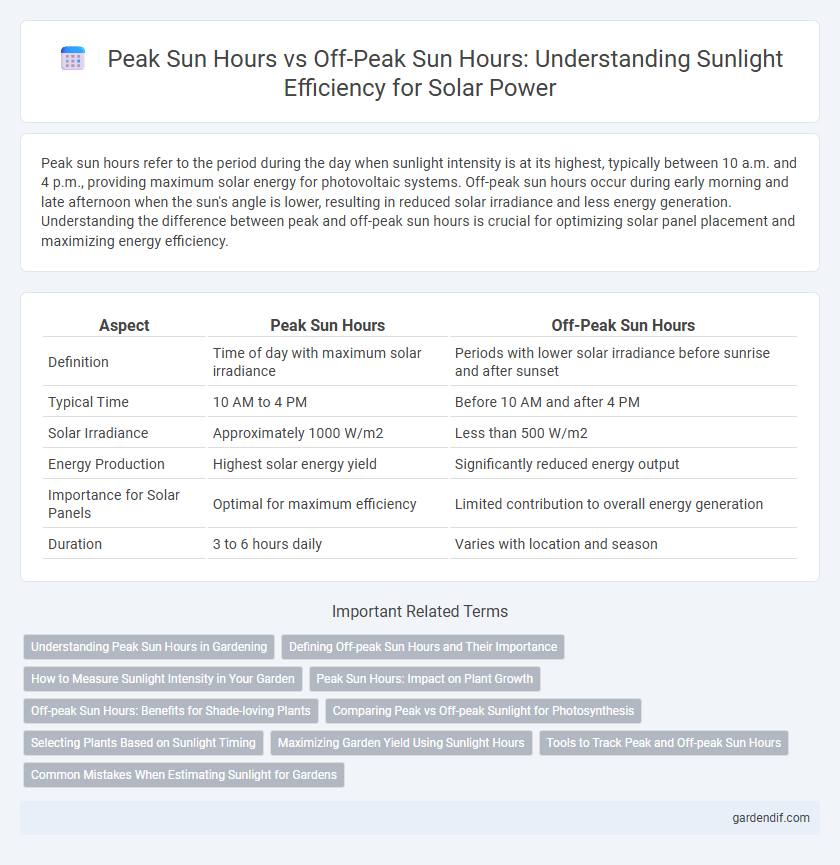
Peak Sun Hours vs Off-peak Sun Hours Illustration
Peak sun hours refer to the period during the day when sunlight intensity is at its highest, typically between 10 a.m. and 4 p.m., providing maximum solar energy for photovoltaic systems. Off-peak sun hours occur during early morning and late afternoon when the sun's angle is lower, resulting in reduced solar irradiance and less energy generation. Understanding the difference between peak and off-peak sun hours is crucial for optimizing solar panel placement and maximizing energy efficiency.
Table of Comparison
| Aspect | Peak Sun Hours | Off-Peak Sun Hours |
|---|---|---|
| Definition | Time of day with maximum solar irradiance | Periods with lower solar irradiance before sunrise and after sunset |
| Typical Time | 10 AM to 4 PM | Before 10 AM and after 4 PM |
| Solar Irradiance | Approximately 1000 W/m2 | Less than 500 W/m2 |
| Energy Production | Highest solar energy yield | Significantly reduced energy output |
| Importance for Solar Panels | Optimal for maximum efficiency | Limited contribution to overall energy generation |
| Duration | 3 to 6 hours daily | Varies with location and season |
Understanding Peak Sun Hours in Gardening
Peak sun hours represent the amount of sunlight intensity equivalent to full, direct sunlight received within a day, typically measuring around 4 to 6 hours in most gardening environments. Understanding peak sun hours is crucial for gardeners to optimize plant growth, as many plants require specific sun exposure to photosynthesize effectively and yield healthy produce. Off-peak sun hours offer lower light intensity and may suffice for shade-tolerant plants, but maximizing peak sun hours ensures optimal photosynthetic activity and garden productivity.
Defining Off-peak Sun Hours and Their Importance
Off-peak sun hours refer to periods of the day when solar irradiance is significantly lower than peak sun hours, typically occurring during early morning, late afternoon, and cloudy conditions. These hours are crucial for optimizing solar energy systems because energy production efficiency decreases outside peak sunlight, impacting battery storage and energy management strategies. Understanding off-peak sun hours enables the design of solar setups that maximize energy harvesting throughout the entire day, improving overall system reliability and sustainability.
How to Measure Sunlight Intensity in Your Garden
Measuring sunlight intensity in your garden involves using a solar power meter or light sensor to record the amount of solar radiation during peak sun hours, typically between 10 AM and 4 PM, when sunlight is most intense. Off-peak sun hours provide lower irradiance levels, which can be quantified by tracking sunlight exposure throughout the day with handheld lux meters or smartphone apps that analyze real-time light intensity. Accurate measurement of sunlight intensity aids in optimizing plant placement for maximum growth and determining the ideal solar panel positioning based on local solar insolation data.
Peak Sun Hours: Impact on Plant Growth
Peak sun hours represent the time period when sunlight intensity is at its highest, typically between 10 AM and 2 PM, delivering the most energy for photosynthesis and significantly boosting plant growth rates. During these hours, the concentration of photosynthetically active radiation (PAR) is maximized, enhancing chlorophyll activity and accelerating biomass accumulation. Plants exposed to optimal peak sun hours exhibit improved flowering, fruiting, and overall health compared to those in off-peak sunlight conditions.
Off-peak Sun Hours: Benefits for Shade-loving Plants
Off-peak sun hours provide diffused sunlight that is ideal for shade-loving plants, reducing the risk of leaf scorch and promoting healthier growth. These plants benefit from lower light intensity and cooler temperatures during off-peak hours, which enhance photosynthesis without stress. Managing exposure to off-peak sunlight ensures optimal hydration and nutrient absorption, supporting vibrant foliage and resilience.
Comparing Peak vs Off-peak Sunlight for Photosynthesis
Peak sun hours deliver intense solar radiation crucial for maximizing photosynthesis, enabling plants to efficiently convert light energy into chemical energy. During off-peak sun hours, reduced light intensity limits the rate of photosynthesis, slowing down carbon fixation and energy production. Understanding the variation in sunlight intensity between peak and off-peak hours aids in optimizing plant growth and agricultural productivity.
Selecting Plants Based on Sunlight Timing
Selecting plants based on peak sun hours is crucial because these hours provide the most intense sunlight necessary for photosynthesis and optimal growth. Off-peak sun hours, which have lower light intensity, are better suited for shade-tolerant or low-light plants that thrive with less direct exposure. Understanding the specific sunlight timing in your garden ensures proper plant placement, maximizing health and productivity.
Maximizing Garden Yield Using Sunlight Hours
Peak sun hours, typically between 10 a.m. and 4 p.m., provide the most intense and direct sunlight essential for maximizing photosynthesis and garden yield. Off-peak sun hours deliver lower light intensity but extended exposure can still benefit shade-tolerant plants and promote overall garden health. Optimizing garden placement and plant selection based on peak sun hour exposure increases growth efficiency and harvest volume.
Tools to Track Peak and Off-peak Sun Hours
Solar irradiance meters and pyranometers are essential tools for accurately measuring peak sun hours, enabling solar panel users to optimize energy production during the most intense sunlight periods. Online solar calculators and weather apps provide location-specific data on off-peak sun hours, helping to plan energy usage and storage efficiently. Data loggers integrated with solar monitoring systems offer real-time tracking of fluctuating sunlight intensity throughout the day, ensuring precise management of solar resources.
Common Mistakes When Estimating Sunlight for Gardens
Many gardeners confuse peak sun hours with off-peak sun hours, leading to inaccurate estimates of sunlight exposure. Peak sun hours represent the period when sunlight intensity is strongest, typically between 10 a.m. and 4 p.m., which directly impacts plant photosynthesis and growth. Estimating sunlight based on total daylight hours rather than peak sun hours often results in overwatering or selecting plants unsuited for the actual light conditions.
Peak Sun Hours vs Off-peak Sun Hours Infographic

 gardendif.com
gardendif.com